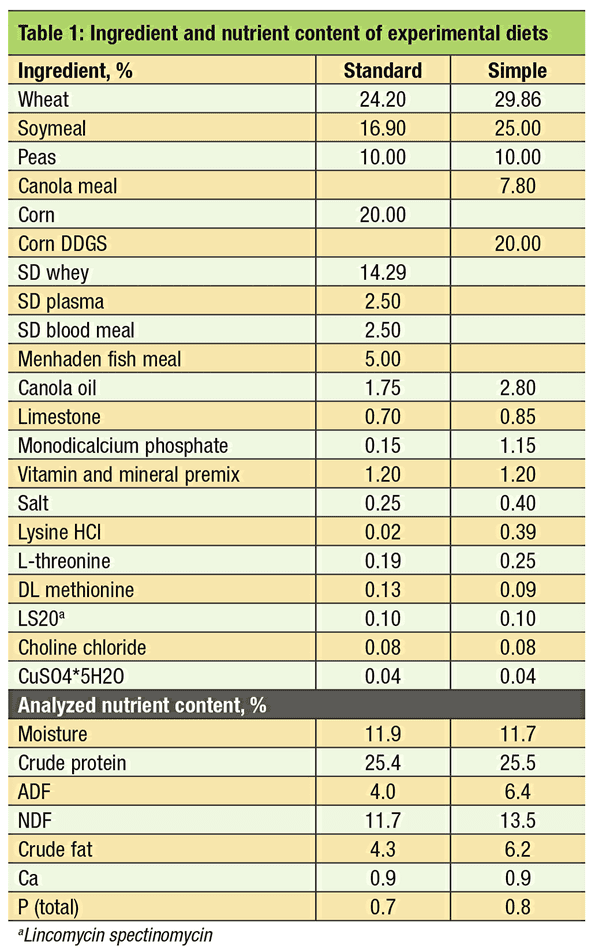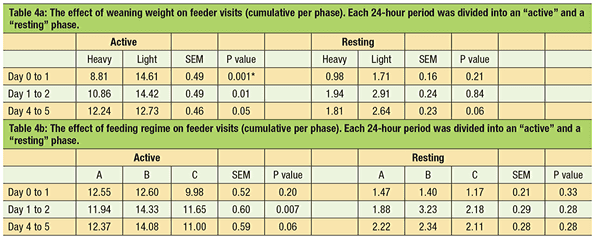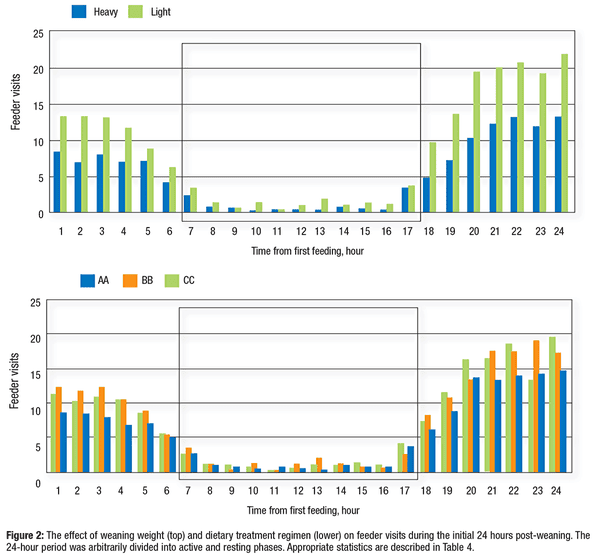Weaned healthy pigs can perform very well on a simple post-weaning diet containing no animal byproducts
June 17, 2015

Feed costs represent the single largest cost of getting a commercial pig to market. A diet that maximizes profitability maintains an optimal level of performance at the lowest cost. Diets formulated for the post-weaning period usually contain highly digestible ingredients designed to aid the transition at weaning from consumption of sows’ milk to solid diets. These ingredients are typically animal byproducts and more expensive than vegetable-based protein sources.
Animal byproducts limit the expression and duration of the “post-weaning growth lag,” a period immediately post-weaning characterized by anorexia and reduced growth. Not all pigs, however, experience this growth lag following weaning and, therefore, may not require a diet with these expensive ingredients. We hypothesized that the heavier pigs could be fed a simpler post-weaning diet without compromising growth. This experiment was therefore designed to determine if body weight at weaning could be used to determine which pigs require the more expensive diet containing the animal byproducts.
Materials and methods
■ Experimental design and treatment
The experiment used 15 nurseries, 12 pens per nursery and eight pigs per pen. Nurseries were filled once per week. Treatments were three dietary regimens and two body weight groupings. Two diets were formulated. The “standard” diet contained animal byproducts, spray-dried whey, spray-dried plasma, blood meal and fish meal. These ingredients are known to provide “extra-nutritional” benefits to the newly weaned pig. The “simple” diet was formulated using less-expensive ingredients and contained no animal byproducts. Both diets met all the requirements for pigs of this age as specified by the National Research Council (2012), were fed as a mash, and are described in Table 1. The experiment began at weaning (day zero) and lasted 14 days. Treatment regimens consisted of the standard diet for day zero to 1 (A), days zero to 4 (B) or not at all (C). The simple diet was therefore fed for 13, 10 or 14 days (Treatments A, B, C, respectively, Table 2).


The two body weight treatments consisted of the heaviest and lightest pigs from each weaning group. Weaning groups averaged about 130 pigs, and the experiment used 96, or approximately 75% of all pigs available each week. Within each nursery there were six pens of “heavy” and six pens of “light” pigs.
■ Animal care
Pigs were weaned at 26 days of age. Care was taken at weaning when moving the pigs from the farrowing room to the nursery so that the time from weaning and introduction to solid feed was the same from week to week. Pens were mixed gender. The heavy and light treatment groups represented the two extremes of body weight of all pigs within the weaning group. Average body weights within each treatment group therefore varied slightly each week.
Feed and water were available ad libitum. Individual body weights and feed disappearance were determined on day zero, 2, 4, 7 and 14 post-weaning.
The post-weaning growth lag is typically preceded by very low, or no, feed intake during the initial 24 hours post-weaning. We wanted to determine if behaviour, such as lack of familiarization with the feeders, accounted for some of this reduced feed intake. The pens were therefore equipped with a video camera to quantitate “feeder approaches.” These were defined as a pig approaching and inserting its snout into the feeder. To accommodate the video recording, the lights remained on for 24 hours per day.
■ Data analysis
The pen was the unit of measure for data analysis, and each nursery was considered a “block,” which allowed us to account for some of the week-to-week variation in weaning weights. The feeder visit data was analyzed using repeated measures, which analyzes the data over the entire day. However, when the feeder visit data was displayed graphically, a diurnal pattern in feeding behaviour was evident. It was therefore decided to divide the data into an “active” and a “resting” phase. The active phase represented hours 1 to 6 and 18 to 24 inclusive (hour 1 represents one hour post-feeding).
Results and discussion
■ Performance
Table 3 provides data on the effect of weaning weight and dietary regimen on the performance of pigs for 14 days post-weaning. We were unable in this experiment to accurately quantitate feed wastage, so feed intake is more accurately expressed as feed disappearance. Additionally, because of the negative or zero gains for some groups for the initial four days post-weaning, feed efficiency has not been calculated for these periods.
 Pigs assigned to the heavy group averaged almost 4 kg or 38% more than those in the light body weight group at weaning (P < 0.01). By day 14, however, while the difference between groups is still evident (P < 0.01), it is now only 26%. The lightweight pigs are “catching up.” The growth rate of the lighter pigs was greater throughout the entire 14-day experiment (P < 0.01). It is interesting that while all pigs lost weight during the initial 24 hours post-weaning, this weight loss is less in the lightweight pigs, even if expressed as a percent of body weight (0.3% versus 2.5% of body weight for the heavy and lightweight pigs, respectively).
Pigs assigned to the heavy group averaged almost 4 kg or 38% more than those in the light body weight group at weaning (P < 0.01). By day 14, however, while the difference between groups is still evident (P < 0.01), it is now only 26%. The lightweight pigs are “catching up.” The growth rate of the lighter pigs was greater throughout the entire 14-day experiment (P < 0.01). It is interesting that while all pigs lost weight during the initial 24 hours post-weaning, this weight loss is less in the lightweight pigs, even if expressed as a percent of body weight (0.3% versus 2.5% of body weight for the heavy and lightweight pigs, respectively).
The lightweight pigs apparently consumed more feed immediately post-weaning than their heavier cohorts (feed disappearance days zero to 1 and 2 to 4, P < 0.01) and feed efficiency was greater with this group of pigs (days 5 to 7 and 8 to 14, P < 0.01; Table 3).
Pigs receiving the standard diet immediately post-weaning (Treatment groups A and B) had higher feed intake (P < 0.01), lower body weight losses (P < 0.01) and, thus, greater body weights on day 5. During days 1 to 4, the pigs on Treatment B, who were still receiving the standard diet at this time, had improved average daily gain relative to those receiving Treatment A or C who were receiving the simple diet (P < 0.01). During the final two weeks of the experiment (days 7 to 14) pigs on Treatment C were growing faster than those who had received the standard, more complex, diet for the initial one or four days (P < 0.05). The diet change (from standard to simple) seemed to negatively affect growth as much as the diet per se.
Results, continued
Surprisingly, there were few interactions between dietary regimen and weaning weight. We had hypothesized that lightweight pigs would respond to the complex standard diet with improved feed intake and growth more so than the pigs that were heavier at weaning. This would be illustrated by a weaning weight by diet regimen interaction, which was not seen (P > 0.10, Table 3.). The exception is the initial 24 hours post-weaning (BW by diet, P = 0.01 ADG, P = 0.03, feed disappearance). Lightweight pigs did poorer on the simple diet (Treatment C) relative to those receiving the complex diet.
In contrast, pigs that were heavier at weaning lost weight regardless of whether they received the simple or standard diet (Figure 1). These differences are also observed with feed disappearance. The heavier pigs consumed more of Treatment A, while the lightweight pigs had better consumption of Treatment B. This is difficult to explain as, during the initial 24 hours post-weaning, pigs assigned to Treatment A or B were both receiving the standard diet.

Testing the hypothesis
To test the hypothesis that feeding behavior influences post-weaning feed intake, video cameras were mounted above the pens, and “feeder visits” enumerated. Tables 4a and 4b describe the effect of weaning weight and treatment regimen on “feeder visits” over 24 hours beginning on day zero, 1 or 4, while Figure 2 shows this data for the initial 24 hours post-weaning only. As seen in Figure 2, despite the lights being on continuously, the pigs displayed a marked diurnal rhythm in their activity. They were active for about six hours post-weaning, rested for 10 hours, then were active for the next 12 to 14 hours. Weaning was completed by about 10 a.m. for each group. These nursery rooms are isolated from the rest of the barn; thus, noise or activity outside the rooms doesn’t explain this pattern.


During the active phase, the lightweight pigs visited the feeder more than their heavier cohorts during all time periods (P < 0.01). This was more pronounced during the latter part of the day, during the second “active” cycle (body weight by hour interaction, P < 0.01). The feed intake data allows us to conclude that more visits correlated with increased feed intake. We don’t have a good explanation for this difference in activity or feeder visits between the two groups of pigs. It would be interesting to see if the difference is maintained in pens that are not segregated by weight.
There tended to be more feeder visits when the feeder contained the standard diet (Table 4b). Although not significant, there is some evidence of this on day zero to 1, indicating a greater attraction or palatability of the standard over the simple diet. This was significant following the diet change on day 1 when only Treatment B pigs are now receiving this diet (P < 0.04, Table 4b). It is interesting that the difference is still observed on day 4, when all are receiving the simple diet (P = 0.06).
Conclusion
Overall, our results show that the standard, more complex diet used in these experiments improved growth and feed intake in the initial 24 to 48 hours post-weaning, and these effects were more evident in the lighter pigs. However, by 14 days post-weaning these differences were no longer apparent. Moreover, while the lightweight pigs had not “caught up” to their heavier cohorts by 14 days post-weaning, their rate of growth was higher, and thus we can assume that nursery exit weights (six weeks post-weaning) would be comparable. Unfortunately this was not measured in the current experiment. However, similar results have been reported by others.
For example, when Skinner and co-workers (J. Anim Sci. 2014; 92: 1044-1054) fed newly weaned pigs either complex or simple diets for the entire nursery period, they found that while the complex diets did improve nursery growth rate, the body weights at market (day 119) were comparable.
Except for the initial 24 hours post-weaning, there were no diet by body weight interactions observed in our experiment and thus no evidence that providing the lighter birth weight pigs a more complex, expensive diet would be economically beneficial. It must be emphasized, however, that our lightweight group represented approximately 36% of the entire group of pigs available each week. These were not the very small or “runt” pigs available each week. The results may be different if we had selected a smaller subset of the very lightweight pigs.
The bottom line is that healthy pigs, weaned at 26 days of age and weighing 6.5 kg, can perform very well on a simple post-weaning diet containing no animal byproducts.
You May Also Like



